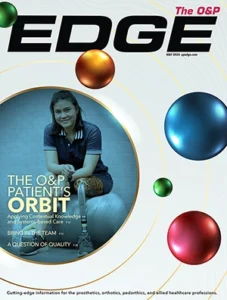My original message requesting information on sprinting feet, and the replies received are posted below:
Hello List;
I have been asked to fabricate a high performance sports prosthesis for a female
client, long left trans tibial (fibular hemimelia), age 20, height 5′ 4″, weight 113
lbs. She is a high jumper, and will be doing some other occasional activities such
as basketball. Jumping and short sprinting is the main function for this prosthesis.
Distal socket to floor clearance is 6″.
My question to you is: What prosthetic foot would you recommend in this case?
Indications / contraindications?
I have been considering using the Flex-Sprint III ‘B’ Mold, or the Springlite
Sprinter foot. I am interested in performance characteristics, socket / foot
clearance, and adaptability from track to gymnasium floor, etc. Other feet
recommendations would be welcome.
——————————————————————————
——————————————————————————
To complete your list, may I add the Otto Bock C-Sprint as an alternative to
the named devices? The foot is similar in shape to the FlexFoot Mod III, but
there are some differences which help customizing the product:
– it utilizes an Otto Bock style Adapter situated at the posterior side of
the socket. Fine adjustments can be made to the alignment without much
effort
– it comes with a detachable “shoe” which has threaded studs for standard
spikes. We have good experience applying a rubber sole to the shoe instead
for leisure sports and long distance running
– two individual Carbon Springs are used in a parallel configuration to give
maximum strength.
With the large number of new products about, Otto Bock Canada may have
missed details about the availability of this niche product.
The feet are custom assembled in Germany to order.
If you are interested, please contact Otto Bock HealthCare in Minneapolis
for details.
——————————————————————————
I haven’t used either of the feet you listed, but am sure that they would do the job,
given the time it takes your client to get used to it. These high performance feet
have a limited application as far as multi-purpose use. Whenever I’ve done this, the
amputee typically comes back after a few months asking if they can trade the (very
stiff) sports foot for something more springy and with heel height adjustments. Only
the very experienced Paralympians get true benefit of a prosthesis for a specific
sport.
I’m also thinking in terms of funding considerations …………………,having
more than 2 prostheses.
I fitted a TT amputee 10 years ago who was (at that time) the world record holder in
the 100, 200 meter sprint and long jump.
I found that watching video tapes in slow motion gave me a good idea as to
socket/foot alignment and possible changes in technique required.
Fibular hemimelias tend to have some knee instability and a higher socket wall, incl.
supracondular control might help.
Without knowing more details, it will be hard to assess how to optimize her
performance. It’s a slow process…………..
—————————————–




